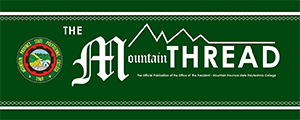The Management Information System (MIS) Unit, in collaboration with the Teacher Education Department spearheaded an undertaking titled “Data Presentation Seminar and Infographics Competition” on October 17-18 at the MPSPC AVR. The two-day training workshop, centering on the educational benefits for the students and employees was also part of the commemoration of the 30th National Statistics Month Celebration.
It was participated by 60 delegates comprised of faculty members, staff, and students from various departments and administrative units in the Bontoc and Tadian campuses. The highlight of the activity was an infographics competition that gauged the extent of learning obtained by the participants.
During the first day, Mr. Sean Camelon A. Ligligen, Coordinator for External Reports of the MIS unit discussed the fundamentals of data presentation, particularly on effective ways of presenting a set of factual information that will provide a partial picture of reality. He further emphasized that data is a very powerful tool in addressing the issues and concerns in a wide area of uses in planning and decision making, people information, policy development, and production. Aside from percentage distribution and percentage index, margin of error (usually small but significant), and outliers (Extreme Value), Mr. Ligligen also underscored that honesty, reliability and consistency are important principles that should be considered in preparing data reports and articles.
To widen the dissemination of the College’s Vision, Mission Goals and Major Thrusts to not only the MPSPC family but also to the wider community which it serves, the MIS Unit through Media Services and Information and Communications Technology (ICT) also introduced various ways of creating an infographics poster to the participants. Ms. Jackielou P. Malot, together with Mr. Jude Anthony I. Baguingey, of the ICT Services Unit of MIS, discussed the steps on creating inforgraphics posters. They also emphasized why and how Adobe Photoshop is a popular software among web designers and image editors, and they integrated these concepts into designing inforgraphics posters.
The Adobe InDesign’s technicalities and application were also explained by Mr. Marcial III P. Pineda and Mr. Meynard A. Pacleba from Media Services to effectively unleash the creativity of the students and employees. During the session, the resource speakers discussed and executed steps in using various unique tools that will enable them to utilize rapid layout features, time-saving effects, and typography support.
Highlighting the activity was the Infographics Competition which commenced after the training. Eighteen teams participated in the competition and they were required to prepare an infographics poster of their respective department or unit. They were also expected to apply the skills that they obtained from the training. The expected outputs should reveal a balance of information, graphics and lay-out that comprise an excellent infographic poster. After consolidating the competing posters, the MIS team published the 18 posters in MPSPC’s social media platforms. For the judging, 30% was allocated for the online media engagement, which means that the poster that obtained the most number of likes and shares get the highest point under this criteria. Other criteria used in the judging included content and relevance with 35% and visual impact and quality with 35%.
The Admissions Office garnered the first spot from the accumulated scores. The Cashiering Office secured the second spot, the Events Management Office took the third spot, the Nursing Department was on the fourth spot, while the Criminology Department bagged the fifth spot.
Special awards like best in layout and design was awarded to the Business Administration Department while the best poster content category was awarded to the Student Services and Development Office.
“The event is very educational because of the contexts presented requiring us to use imagery to highlight, explain, or enhance text-based information,” Ms. Flora Mae A. Apos, a student participant said in an interview. “The organizers effectively shared their unique ability to capture attention, convey information, and encourage data retention despite its complex nature.”









